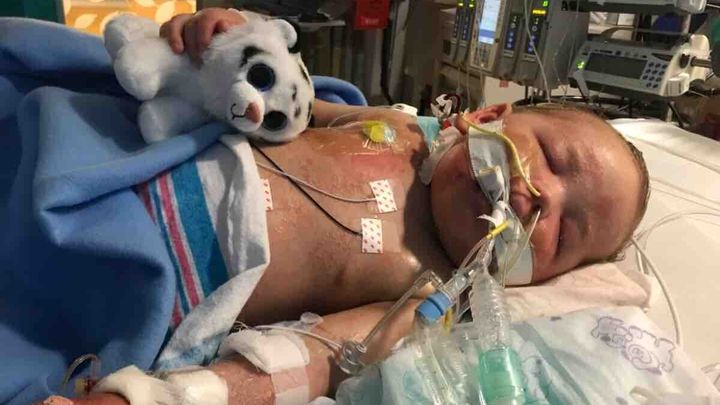
Mason Pritchett Family
Donation protected
Welcome and thank you for taking interest in Mason’s story. Mason was born with a rare blood disorder effecting 1-2:1,000,000. Mason’s diagnosis came after multiple bacteria infections that got so bad it spread into his mastoid bone and broke down the bone causing a large lump behind his ear. Mason had emergency surgery and had blood work done which showed that Mason was missing a white blood cell referred to as neutrophils. Neutrophils are critical in fighting bacteria and other infections of the body. Without them, the body is unable to fight infections and can be life-threatening. Mason’s diagnosis, Severe Congenital Neutropenia (SCN) was confirmed through genetic testing and we learned that the only cure for Mason’s condition was a stem cell transplant, also known as a bone marrow transplant. After consulting with the Oncology Team we elected to move forward with a transplant.
In early 2017 we began the search for a match and no one in the immediate family was a match. The hospital found a unrelated match in Germany. In May 2017, Mason was admitted and started chemotherapy in advance of the transplant. After nine days of chemo Mason was given new life, he was given his new cells. For the next six weeks weeks Mason was in isolation being cared for by his parents, doctors and nurses. A few weeks post transplant we were expecting Mason’s bone marrow to produce cells but were not. By week four Mason had bone marrow biopsy after concerns of a failed graft. The biopsy confirmed the failed graft and that his bone marrow was dry. The doctors confirmed that Mason would require an emergency second transplant but will come with significant risks including effects of more chemotherapy and Graft v Host Disease among other things. During this time Mason was kept with us by getting daily blood transfusions of hemoglobin and platelets.
For the next week the doctors worked to request more cells from the donor but advised that the cells would not be from the donor’s bone marrow. Instead Mason would have an peripheral blood stem cell transplant. His first was referred to an allogeneic bone marrow transplant. The peripheral transplant comes with much greater risks as it has more impurities which cause complications but we had no choice. By June Mason started his second, more intense, round of chemotherapy which included radiation and in July, Mason was given his new cells. Within two months Mason’s we started to see new cells, including neutrophils. Mason had grafted. During this time Mason was very sick and his body was broken down as a result of the chemotherapy. By late fall Mason was well enough to go home but would continue to be treated. In December of 2017 we began to notice severe rashes on Mason and the doctors confirmed that Mason had developed Chronic Graft v Host Disease (cGVHD).
Mason continued to be treated for complications from the transplant and began treatment for cGVHD. The treatment included a lineup of about 8-12 drugs from steroids to immune suppression. As a result Mason’s immune system was very delicate and very susceptible to infections. After several months the cGVHD was getting worse and the doctors tried various medications to get it under control. Mason kept getting infections and for him, it’s life threatening. In late May Mason begin a new treatment regime. In mid-June, within a few hours Mason’s condition changed rapidly. He couldn’t eat or drink anything and began vomiting. We rushed him to the hospital and learned that Mason had a rare reaction to one of the drugs and some of his organs began to fail and had respiratory failure. Additionally, Mason cells were being destroyed as he developed Thrombotic Microangiopathy (TMA). Mason was placed on a paralytic and kept asleep for the next four weeks while being treated. This was the closest we came to losing our son.
By late summer 2018 Mason’s body was improving and he begin building a tolerance to the paralytic and began to move. The doctors began the long process of weaning the drugs (which continued into late 2018). By late August Mason was fully awake and we began rehabilitation in-patient rehabilitation. During Mason’s recovery the GvHD had spread and he developed cGvHD of the gut.
Since them Mason has been released and his home. Mason continues to be treated for cGvHD and other complications from the transplant, the reaction to the immune suppression drug and complications from some of the other drugs including the steroids. Mason has been on high doses of steroids for over a year now in an attempt to help control his cGvHD. He’s developed severe myopathy which presents as weakness in his muscles. He can’t do things typical of three-year-olds. The severity comes and goes as the volume of steroids change. The volume is based on the severity of the cGvHD.
In January 2019, Mason began a new treatment regime as we work to control the cGvHD. His treatment include cyclosporine, steroids, infliximab and photopheresis among many other medications. He continues to require TPN which is an overnight feeding through his venous port. He receives daily treatments at home and weekly at Lurie Children’s of Chicago. Most importantly, Mason is one of the happiest three-year-old boys you’ll ever meet. His energy, care, resilience are infectious. You will love him the moment you meet him.
Organizer and beneficiary
Jana Huffman Olin
Organizer
Naperville, IL
Chris Pritchett
Beneficiary


